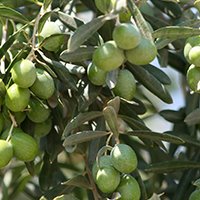Geolive is a specialist olive nursery producing the largest range of olive varieties and tree sizes in Georgia. All olive varieties are propagated from mature motherstock trees that have been verified as true to type using DNA or morphological techniques.
About Geolive
Each of the plants displayed within our nursery have been specifically chosen and hand-selected by ourselves, taking into careful consideration its quality, form, shape and most importantly its price. Ensuring that we can offer the best value, quality stock to our customers is of high importance to us and paramount to the success of our business.


Gemlik Olive Sapling
The homeland of Gemlik olive saplings is Anatolia. Other names of Gemlik olives are also known as curly, black and kapilik olives.

Gemlik 21 Olive Sapling
Gemlik 21 olive have medium-sized fruits and the tree characteristics will be medium strong and the fruit quality will be at the highest level.

Gemlik 27 Olive Sapling
Among hundreds of sapling varieties, gemlik olive is the most preferred sapling type. The high oil yield rate of this olive variety increases the interest shown in Gemlik olive saplings.
Olive thrives in almost all types of soil, but it is best grown on carbonate-brown, alluvial soils and dry stony slopes. Olive can withstand -7 : -9 degrees of frost.
In Georgia, in the dry subtropical zone of Abkhazia and Kakheti, olive culture has been widespread since time immemorial. There are historical facts of the existence of olives in Georgia.
Olive trees are native to the Mediterranean, so they thrive in a climate where the summer is long, hot and dry and the winter is cool .
Not suited to the tropics, they will grow well in temperate climates and even along coastal areas. Plant olive trees in full sun where the plant will receive at least six hours of direct sunlight. Place it in a position that is protected from strong winds or stake well.
For Contractors
Selecting, transporting and installing trees without a precise plan and within a well-coordinated time frame will create added cost and frustration for everyone involved. The Geolive Olive Tree Farm will work closely with you to develop a complete plan and select, deliver and install olive trees best suited for the specifications you and your clients require.
For Developers
When landscaping is planned and executed utilizing natural topography, selecting trees well adapted to the specific climate and conditions, and choosing varieties best suited to the site and upkeep requirements, buyers will be enticed by the drama and stately form that are the hallmark of olive trees and the benefits of well-planned site design.


Are Olive Farms Profitable?
Olive farms in Georgia are indeed very profitable in the mid and long term, provided the climate and the region are suitable for growing olive trees. However, as it happens in nearly all agriculture and livestock commercial activities, the first year is introductory and a farmer shall make a small rational investment in order to test his/her strength and acquire a basic understanding of the market, without expecting a considerable income. During the second, the third and the fourth years, the farmer will acquire enough farming experience and market data in order to decide on extending the investment to a larger scale, selecting another location/ variety, adjusting cultivation methods or divest.

Especially when cultivating olive trees, a farmer shall be patient, because olive trees achieve good yields after their 5th or 6th year of life. This means, that if a farmer selects and plants young trees of 2-3 years old, then he/she shall expect good yield about 2-4 years after the establishment of the olive farm. Moreover, as it happens in nearly all fruit trees, you need economies of scale. This means that you cannot make a good income and live solely from growing 30 or 50 olive trees, because fixed costs will surely reach (if not exceed) earnings. The minimum number of trees providing a good income ranges from country to country. However, we can say that a farm of 1 hectare (10.000 square meters) with 300 trees is a good start.


